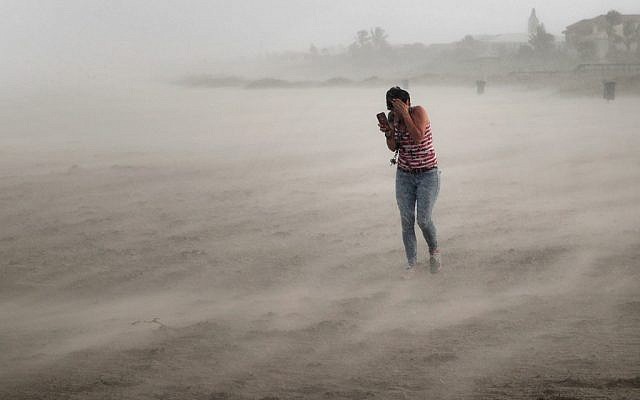FREEPORT, Bahamas (AP) — Practically parking over the Bahamas for a day and a half, Hurricane Dorian pounded away at the islands Tuesday in a watery onslaught that devastated thousands of homes, trapped people in attics and crippled hospitals. At least five deaths were reported, with the full extent of the damage far from clear.
The United Nations and the International Red Cross began mobilizing to deal with the unfolding humanitarian crisis in the wake of the most powerful hurricane on record ever to hit the Bahamas.
Dorian’s punishing winds and torrential rain battered the islands of Abaco and Grand Bahama, which have a combined population of about 70,000 and are known for their marinas, golf courses and all-inclusive resorts. The Grand Bahama airport was under 6 feet (2 meters) of water.
Bahamian officials received a “tremendous” number of calls from people in flooded homes, and desperate callers trying to find loved ones left messages with local radio stations.
One station said it got reports of a 5-month-old baby stranded on a roof and a woman with six grandchildren who cut a hole in a roof to escape rising floodwaters. At least two storm shelters flooded. The U.S. Coast Guard airlifted at least 21 people injured on Abaco. Rescuers also used jet skis to reach some people.
“We will confirm what the real situation is on the ground,” Health Minister Duane Sands said. “We are hoping and praying that the loss of life is limited.”
Tammy Mitchell of the Bahamas’ National Emergency Management Agency told ZNS Bahamas radio station that authorities had documented every call and were prioritizing them, but that rescue crews were forced to turn back in some cases because the wind was so fierce and the water so high.
“We understand what everybody was going through,” she said. “We wanted to go out there … but that’s not a risk we’re capable of taking. We don’t want people thinking we’ve forgotten them.”
Ahead of the storm, over 2 million people in Florida, Georgia and North and South Carolina were warned to evacuate as Dorian closed in on the Sunshine State on a projected track expected to take it up the Southeast coast. The threat of a direct hit on Florida had all but vanished, but the storm was expected to pass dangerously close to South Carolina — and perhaps strike North Carolina — on Thursday or Friday, according to the National Hurricane Center.
In the Bahamas, Red Cross spokesman Matthew Cochrane said more than 13,000 houses, or about 45% of the homes in Grand Bahama and Abaco, were believed to have been severely damaged or destroyed. U.N. officials said more than 60,000 people on the hard-hit islands will need food, and the Red Cross said some 62,000 will need clean drinking water.
The Red Cross authorized a half-million dollars for the first wave of disaster relief, Cochrane said.
“What we are hearing lends credence to the fact that this has been a catastrophic storm and a catastrophic impact,” he said.
As of 11 a.m. EDT, Dorian’s winds had dipped to 110 mph (177 kph), making it a Category 2 hurricane, down from a terrifying Category 5 when it struck. The storm was centered about 45 miles (70 kilometers) north of Freeport and 105 miles (170 kilometers) east of Fort Pierce, Florida.
After standing still for nearly a day, it was on the move again, but just barely, pushing northwest at 2 mph (3 kph), or about as fast as a person walks. Hurricane-force winds extended up to 60 miles (95 kilometers) from its center.
NASA satellite imagery through Monday night showed spots in the Bahamas where Dorian had dumped as much as 35 inches (89 centimeters) of rain, said private meteorologist Ryan Maue.
The Bahamas’ health minister said that Dorian devastated the health infrastructure on Grand Bahama and that severe flooding rendered the main hospital there unusable.
Sands said the main hospital in Marsh Harbor in the Abaco islands was intact and sheltering 400 people but in need of food, water, medicine and surgical supplies. He said crews were trying to airlift five to seven kidney failure patients from Abaco who had not received dialysis since Friday.
Across the stricken islands, choppy brown floodwaters reached roofs and the tops of palm trees. Parliament member Iram Lewis said he feared waters would keep rising and stranded people would lose contact with officials as their cellphone batteries died.
“It is scary,” he said, adding that people were moving from one shelter to another as floodwaters kept surging. “We’re definitely in dire straits.”
To the south, the Bahamas’ most populous island, New Providence, which is the site of the capital, Nassau, and has over a quarter-million people, suffered little damage.
Leaving one person dead in its wake in Puerto Rico, Dorian hit the Bahamas on Sunday with sustained winds of 185 mph (295 kph) and gusts up to 220 mph (355 kph). It tied the record for the strongest Atlantic storm ever to hit land, matching the Labor Day hurricane that struck Florida Gulf Coast in 1935, before storms were given names.
Scientists say that climate change generally has been fueling more powerful and wetter storms but that linking any specific hurricane to global warming would require more detailed study.
Across the Southeast, meanwhile, interstate highways leading away from the beach in South Carolina and Georgia were turned into one-way evacuation routes. Several large airports announced closings, and hundreds of flights were canceled. Walt Disney World in Orlando planned to close in the afternoon, and SeaWorld shut down.
Having seen storms swamp his home on the Georgia coast in 2016 and 2017, Joey Spalding of Tybee Island decided to empty his house rather than take any chances with Dorian.
He packed a U-Haul truck with tables, chairs, a chest of drawers, tools — virtually all of his furnishings except for his mattress and a large TV — and planned to park it on higher ground. He also planned to shroud his house in plastic wrap up to shoulder height and pile sandbags in front of the doors.
“In this case, I don’t have to come into a house full of junk,” he said. “I’m learning a little as I go.”







